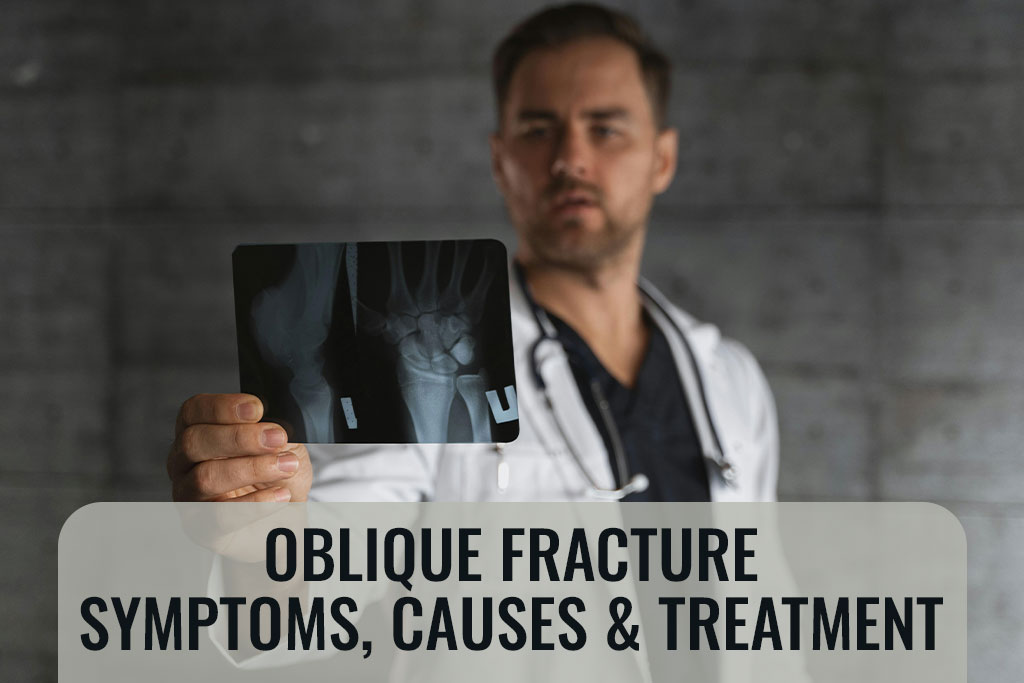A fracture is defined as a break or loss of continuity in the bone. There can be a crack in the bone or a whole or partial fracture. The force utilized to break the bone such as a high-energy or low-energy trauma determines the severity of the fracture. Automobile accidents, sports injuries, direct blows, etc. are examples of high-energy trauma. Falls from a ladder or standing height are examples of low-energy trauma; in certain situations, fractures may be associated with these falls.
What Is An Oblique Fracture?
One kind of fractured bone is an oblique fracture. They occur when an angle fracture occurs in one of your bones. Oblique fractures may also be referred to as full fractures. This indicates that the break’s line passes through your entire bone.
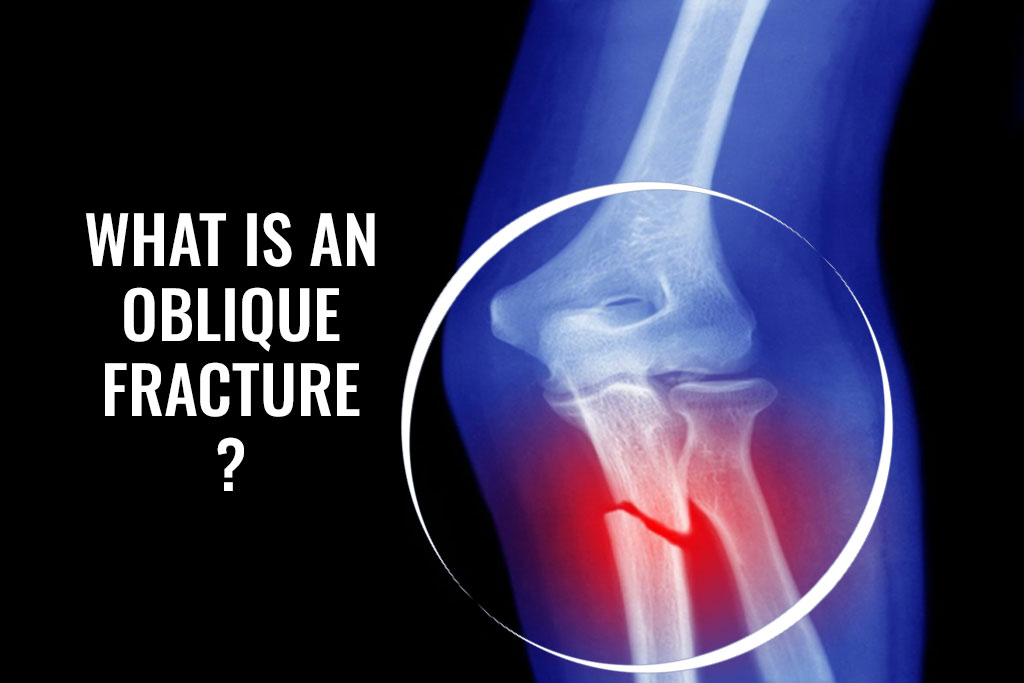
Long bones in your body are typically affected by oblique fractures. Among the most typical are:
- Femur (thigh).
- Tibia (shin).
- Fibula (calf).
- Humerus (upper arm).
- Radius and ulna (forearm).
- Clavicle (collarbone).
Accidents and other traumas are mostly always the cause of oblique fractures. To fix your broken bone, surgery might be required. Some people’s broken bones can recover with just a cast or splint. Your recovery time will vary depending on which bones are broken and what caused them—the average recovery time after an oblique fracture is several months.
Spiral vs Oblique Fracture
There are two forms of bone fractures: oblique fractures and spiral fractures. These are distinct phrases that offer your healthcare professional particular information about the type of fracture you have and its shape.
Your bone might break at an angle, resulting in an oblique fracture. The fracture appears as an angled, straight line spanning the width of your bone. They are typically brought on by falling onto your bone at an angle or by an abrupt blow to it from an angle (such as in a car accident).
When a fracture loops around the length of your bone, resembling a spiral staircase, it is called a spiral fracture. They frequently occur in sports-related injuries when a person’s bones are severely bent (such as when they are tackled in football).
Transverse vs Oblique Fracture
Both oblique and transverse fractures result in a break that crosses the breadth of your bone perpendicularly.
An oblique fracture is inclined across your bone. Transverse fractures occur in a direction opposed to the direction of your bone and travel horizontally perpendicular to it.
Getting your injury checked out by your healthcare professional as soon as possible is the most crucial first step, regardless of the labels and phrases that are eventually attached to your fracture.
Who Gets Oblique Fractures?
Like other bone fractures, oblique fractures can happen to anyone. This is particularly true when traumas or falls are the cause of them. An oblique fracture may be more likely to occur if you are at risk for falls. Osteoporosis, or weakening of the bones, increases the risk of fractures of all kinds, particularly oblique fractures.
How Common Are Oblique Fractures
Oblique fractures are one of the most common kinds of broken bones, especially in long bones.
Causes of Oblique Fracture
A few reasons why oblique fractures occur are as follows:
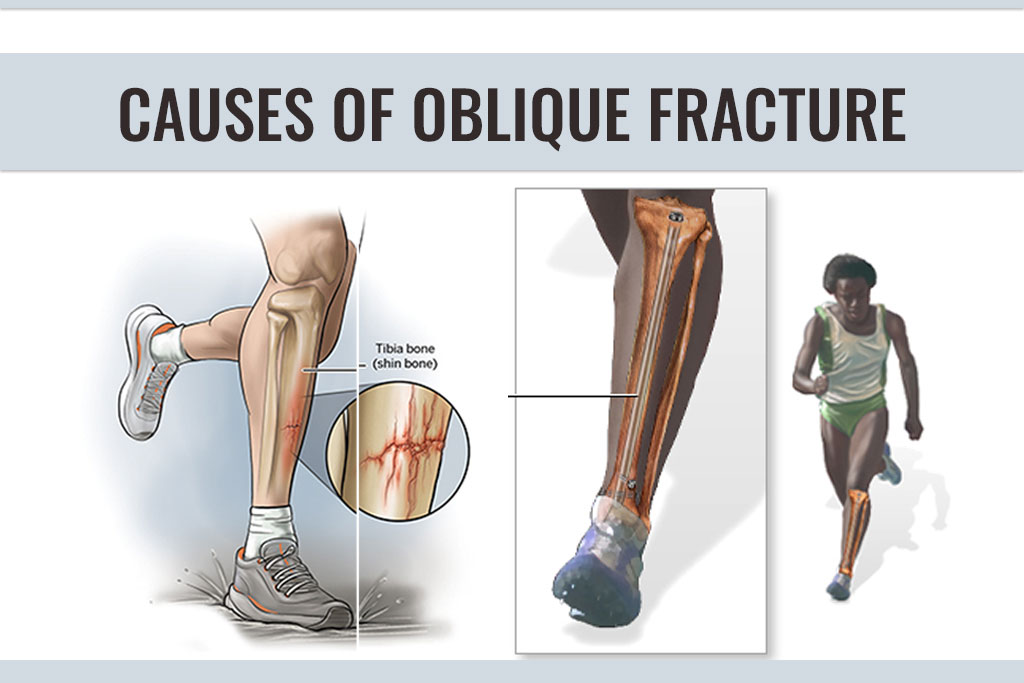
- Trauma with a high energy level, such as assault, car crashes, sports injuries, etc.
- Falling or being struck at an angle by a sharp object can cause fractures.
- A quick turn is made when playing or jogging.
- People who have low bone density or osteoporosis are more likely to break.
- Frequent athletes frequently suffer from stress fractures as a result of repetitive muscular actions that put a strain on their bones.
Symptoms of Oblique Fracture
Some symptoms and signs are:
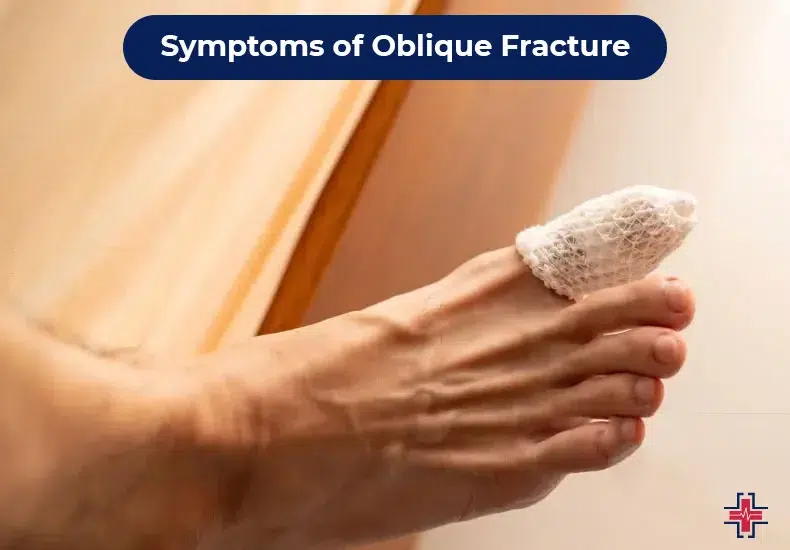
- Extreme edema and discomfort.
- Sensitivity of the impacted region.
- When there are injuries, there are bruises, cuts, and abrasions on the skin.
- Immobility of the afflicted area.
- An unusual lump or a large malformation.
- Bone pieces that poke through the skin are linked to bleeding in cases of compound or open fractures.
How Are Oblique Fractures Diagnosed?
After obtaining the patient’s whole medical history, the physician examines the fractured area physically. The fracture site is palpated to feel discomfort and checked for bleeding, abrasions, bruises, and lacerations. After determining the fracture’s site and extent, a radiographic evaluation is conducted. It consists of
- X-rays: They provide a clear picture of the position, kind, displacement (or lack thereof), and size of fractures. They can also reveal further fractures or abnormalities in the bone.
- Magnetic resonance imaging (MRI): To obtain a comprehensive image of the damage to your bones and the surrounding tissue, your healthcare professional may employ an MRI. They can see the tissue surrounding your bones thanks to this. Determining whether your muscles, connective tissue, and organs were harmed is very crucial.
- CT scan: Your surgeon or healthcare professional needs to know the precise extent of your bone damage if you require surgery. Compared to an X-ray, a CT scan will provide them with a more precise image of your bones and the surrounding tissue. If your X-rays were unclear or to assist your surgeon in planning your surgery, you may require a CT scan.
What Is The Treatment of Oblique Fractures?
The patient’s age, accompanying injuries, type, location, and severity all influence how an oblique fracture is treated. To reduce pain and swelling, doctors recommend analgesics and anti-inflammatory treatments, such as nonsteroidal anti-inflammatory drugs like acetaminophen, ibuprofen, etc. Rehabilitation therapy with physical exercises comes after surgery. Treatment options for oblique fractures include the following:
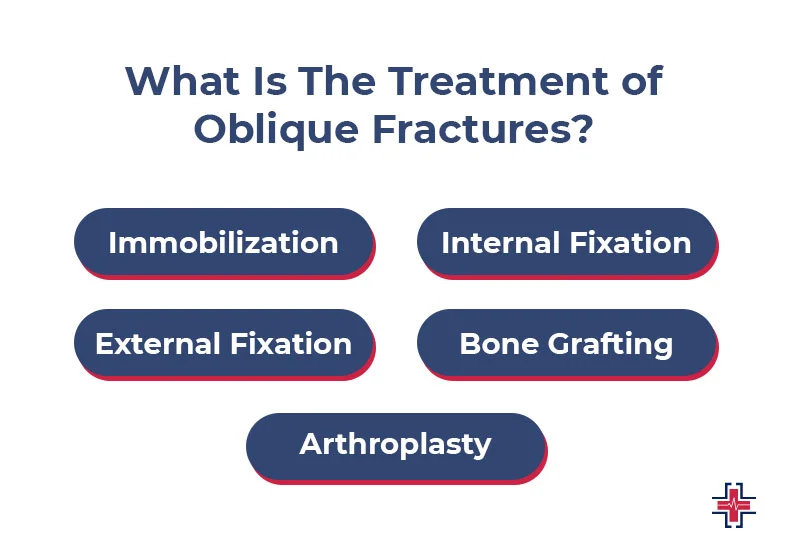
Immobilization
A cast or splint is used to immobilize the bone for four to six weeks in the case of simple and nondisplaced fractures. X-rays are used for routine monitoring to stop displacement.
You’ll probably need a cast for a longer period—six to eight weeks, if necessary. You’ll probably want more X-rays in both situations to ensure that your bones are healing properly.
Internal Fixation
Surgery is necessary for the most severe fractures. To allow your bones to mend and grow back together, your surgeon will realign (set) them to their proper position and then secure them in place. Typically, they carry out an internal fixation, in which your surgeon places small metal bits into your bone to stabilize it while it heals. To ensure that your bone heals completely, you’ll likely need to minimize how much you utilize the surgically treated area of your body.
Techniques for internal fixation consist of
- Rods: A rod that runs from top to bottom and is put into the middle of your bone.
- Plates and screws: To keep the parts together in situ, metal plates are screwed into your bone.
- Pins and wires: Too-small bits of your bone are secured in place by pins and wires. Usually, they will be utilized concurrently with either rods or plates.
Some people have these implants in them permanently. It may require more procedures to eliminate them.
External Fixation
You may require an external fixation. An external brace or bracket will be placed around the outside bone after your surgeon drives screws into the bone on either side of the internal fracture. Usually, this is a stopgap measure to stabilize your fracture and allow it to heal before receiving an internal fixation.
Bone Grafting
If your oblique fracture is badly displaced or if your bone isn’t mending back together as it should, you may require bone grafting. To repair your broken bone, the surgeon will introduce more bone tissue. Following that, an internal fixation is typically performed to hold the fragments together while your bone grows back. There are several sources for bone grafts:
- Internally from another location within your body, typically the upper part of your hip bone.
- An outside contributor.
- A synthetic substitute component.
Typically, oblique fracture surgeries don’t require hospitalization, and you should be able to return home the same day. A longer hospital stay may be required following surgery on a bigger bone (such as your femur).
The area of your body with the broken bone will be immobilized following surgery. It will take a combination of a cast, splint, or brace before you can begin bearing weight again or utilizing it in the same way that you did before the fracture.
Arthroplasty
It is typically performed in patients with severe osteoarthritis, post-traumatic arthritis, or displaced fractures including joint involvement. To restore function, the joint is surgically repositioned, modified, or replaced with an artificial joint composed of ceramic or metal.
Home Remedies For Oblique Fracture Treatment
Although treating an oblique fracture might be difficult, some do-it-yourself therapies can help ease the pain. It’s crucial to remember that these treatments are adjunctive and shouldn’t take the place of expert medical counsel. Always seek the advice of a medical expert for a thorough treatment plan.
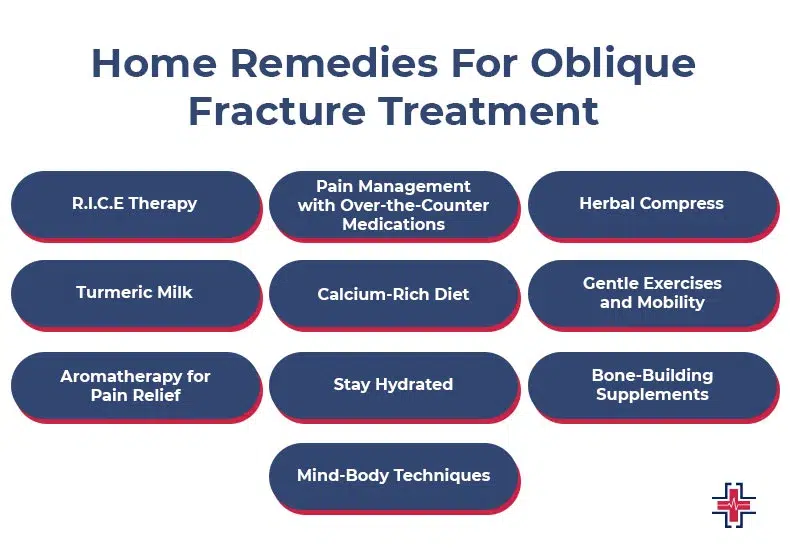
R.I.C.E Therapy:
A key strategy for treating fractures is Rest, Ice, Compression, and Elevation, or R.I.C.E. Use compression bandages, elevate the limb to reduce inflammation, rest the affected area, and apply ice to reduce swelling.
Pain Management with Over-the-Counter Medications:
Non-prescription pain relievers such as ibuprofen or acetaminophen can help manage pain and reduce inflammation. Follow the recommended dosage and consult a healthcare professional if needed.
Herbal Compress:
Herbal compresses can provide relief by combining the anti-inflammatory properties of herbs with the soothing effect of heat. Compresses made from herbs like arnica, chamomile, or comfrey can be applied to the affected area.
Turmeric Milk:
Turmeric contains curcumin, a natural anti-inflammatory compound. Adding turmeric to warm milk and consuming it can potentially help in reducing inflammation and promote healing.
Calcium-Rich Diet:
Enhance your diet with calcium-rich foods to support bone health. Include dairy products, leafy greens, nuts, and seeds to ensure an adequate intake of calcium, which is crucial for bone healing.
Gentle Exercises and Mobility:
While rest is essential, gentle exercises that do not aggravate the fracture can promote blood circulation and prevent stiffness. Consult with a healthcare professional or physiotherapist for appropriate exercises.
Aromatherapy for Pain Relief:
Essential oils like lavender, eucalyptus, and peppermint can be used for aromatherapy to help manage pain. Dilute essential oils with a carrier oil and apply them topically, or use a diffuser for inhalation.
Stay Hydrated:
Proper hydration is essential for overall health and can aid in the healing process. Ensure an adequate intake of water and avoid excessive consumption of caffeinated or sugary beverages.
Bone-Building Supplements:
Consult with a healthcare professional about the potential use of supplements like vitamin D and calcium to support bone health and aid in the healing of fractures.
Mind-Body Techniques:
Practices such as meditation and deep breathing can help manage stress, which may contribute to the overall well-being during the healing process. Reducing stress can indirectly support the body’s healing mechanisms.
Reverse Oblique Hip Fractures
One type of hip injury that is different from others is a reverse oblique hip fracture, which happens when the femur breaks diagonally in the opposite direction. This fracture, which usually results from severe trauma, requires immediate diagnosis and treatment. Clinical assessment and imaging examinations are necessary for the diagnosis; CT and X-rays show the fracture in great detail. To stabilize the hip, surgery is frequently required, utilizing internal fixation devices like screws or plates. Physical therapy is used in rehabilitation to help patients regain their mobility and functionality.
Problems like infection or decreased joint function may occur, affecting the prognosis which varies according to age and general health. Healthcare providers must be well-versed in the nuances of treating patients with reverse oblique hip fractures to guide them through a thorough rehabilitation program and facilitate a quicker recovery.
Displaced Oblique Fractures
Your healthcare physician may also refer to your fracture as non-displaced or displaced. When a bone fracture is displaced, it indicates that the fragments moved so much that a gap opened up surrounding the fracture. Although the components of a non-displaced fracture were not shifted far enough to cause an alignment problem during the break, the bones are nonetheless broken. Surgery is far more likely to be necessary to heal displaced fractures.
Open vs. Closed Fractures
Your fracture will be classified as either open or closed by your healthcare provider. Your bone pierces through your skin when you have an open fracture. Open fractures are more likely to become infected and cause additional problems, as well as taking longer to heal. Although your bone does not pierce through your skin, closed fractures are nevertheless quite dangerous.
What is The Oblique Fracture Healing Time?
The healing time for an oblique fracture can vary depending on various factors, including the specific location of the fracture, the extent of the injury, and the individual’s overall health. In general, oblique fractures, like other types of fractures, typically follow a timeline for healing.
For minor oblique fractures, where the bones are not significantly displaced, healing may take approximately 6 to 8 weeks. During this time, the body works to repair the fractured bone, and the affected individual may gradually regain mobility and function.
However, more complex or severe oblique fractures, especially those requiring surgical intervention to realign the bones or stabilize them with hardware like screws or plates, may have a longer healing process. In such cases, it can take several months for the fracture to fully heal.
It’s essential to note that individual variations, such as age, overall health, and adherence to the prescribed treatment plan, can also influence the healing time. Regular follow-ups with healthcare professionals and adherence to recommended rehabilitation exercises are crucial to monitor progress and promote optimal healing.
Ultimately, only a qualified healthcare professional can provide an accurate estimate of the healing time based on the specific details of the oblique fracture and the individual’s unique circumstances. If you suspect an oblique fracture, seeking prompt medical attention is essential to receive an accurate diagnosis and appropriate treatment plan.
FAQs
How soon after an injury should one seek medical attention for a suspected oblique fracture?
Recognizing the urgency of seeking medical attention is crucial for optimal outcomes. Understanding the ideal timeframe for seeking help can minimize complications and expedite the healing process.
Are there specific precautions to take during the healing process of an oblique fracture?
Patients with oblique fractures may need to take precautions to ensure a smooth healing process. Understanding these precautions and following medical advice can prevent setbacks in recovery.
Can oblique fractures affect joint function?
In certain cases, oblique fractures may impact joint function, especially if they involve joints like the hip. Understanding the potential effects on joint function and seeking appropriate treatment is essential.
What is the role of physical therapy in oblique fracture recovery?
Physical therapy is often recommended after surgery to promote mobility and functionality. Understanding the importance of rehabilitation exercises can contribute to a smoother recovery process.
Conclusion:
If you or a loved one is experiencing symptoms of an oblique fracture, don’t hesitate to visit the ER of Mesquite, our dedicated emergency hospital in Mesquite. Our experienced healthcare professionals are ready to provide accurate diagnoses, and comprehensive treatment plans, and guide you through a successful recovery. Your health and well-being are our top priorities. Seek medical attention promptly to ensure the best possible outcome.
